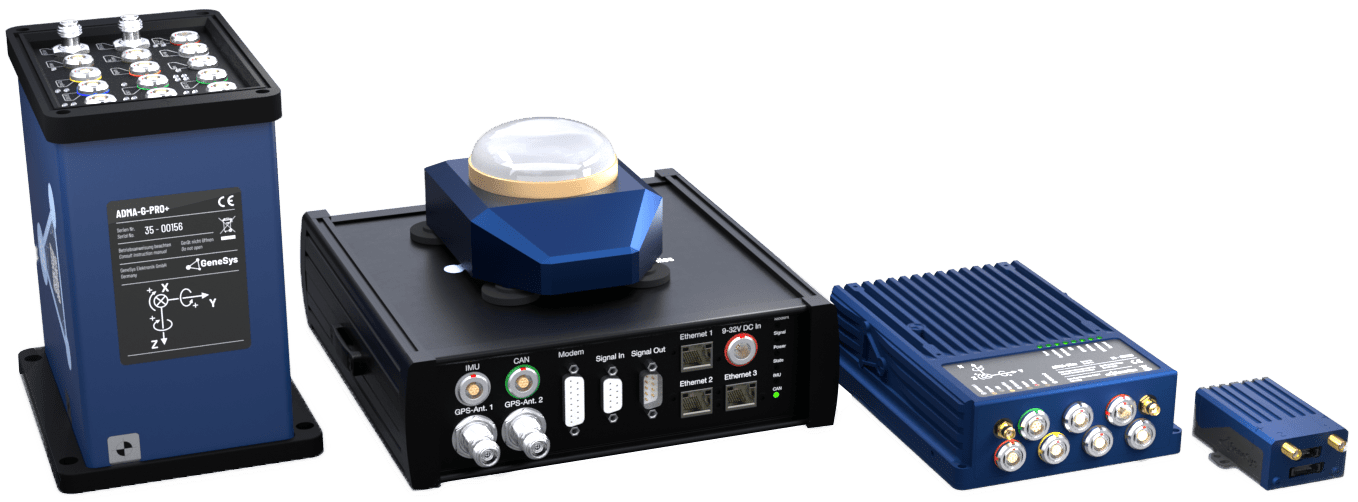ADMA-Speed is the compact GPS speed sensor from GeneSys featuring inertial sensor-based technology. The braking distance sensor eliminates the well-known disadvantages of standard GPS speed sensors and therefore puts out a precise, smoothened and continuous speed signal – even with poor GPS reception. Thus, centimetre-accurate and speed-triggered braking distance measurements now are possible.
The compact unit is optimized for brake tests and supplies exactacceleration, speed and braking distance data, also the achieved measurement accuracy. The settings for braking distance calculation are configured quickly and easily via a web browser. With ADMA-Speed, parameter input is just as fast as the subsequent output of measured and braking distance data: in real time and directly via CAN interface and Ethernet.
In addition to braking performance specifications according to DIN now software enhancements for acceleration tests and measuring of lateral deviation are available, also in real time. At any time, ADMA-Speed can be extended to a full-fledged GPS-aided inertial system. ADMA-Speed is small, compact and easy to install. Thanks to these characteristics, ADMA-Speed is ideal for braking distance measurements.
Further development of vehicle and brake technology places added demands on the measurement accuracy, quality, and repeatability of the results and the need for enhanced technology. All vehicle movement data can be calculated reliably and precisely using the proven ADMA technology from GeneSys.

ADMA-Speed is the little brother of the ADMA (Automotive Dynamic Motion Analyzer) and consists of an evaluation unit and a separate sensor unit. The evaluation unit, weighing roughly 2 kg, houses the tried and tested ADMA Kalman filter technology. This unit calculates the movement data of the vehicle at its center of gravity. The output of the acceleration, speed, and braking distance data according to ISO standard occurs – in real-time – via the CAN interface and simultaneously via Ethernet. Logger software for Windows™ is available for data storage and display of the braking distance data via Ethernet.

At the heart of the extremely precise speed and braking distance sensor, ADMA-Speed is the sensor unit with a GPS antenna and integrated inertial sensor-based technology. ADMA-Speed is very easy to handle as it weighs just 750 g and has a length of 11 cm. The simplest way to attach the sensor unit of the speed sensor is with strong magnets to the vehicle roof directly above the center of gravity.
The standard GPS measuring method without inertial sensor-based technology has the disadvantage of requiring a clear view of the sky to ensure accurate measuring results. In real-life situations, the GPS signals and the achievable measurement accuracy are affected by buildings, trees, fences, and vehicles. The inertial measuring unit suppresses signal interference during poor GPS reception or temporary GPS failure. The combination of GPS and inertial measuring unit in ADMA-Speed, therefore, provides a distinctly smooth and consistent speed signal compared to a standard GPS signal.

Furthermore, ADMA-Speed compensates for GPS data latency and corrects acceleration-dependent GPS signal distortion. ADMA-Speed additionally uses GLONASS, which considerably enhances satellite reception even on wooded test routes. The typical accuracy of the braking distance measurement is 5 cm, the speed is measured with an accuracy of 0.05 km/h
Pitching movements, which inevitably occur during the brake stop, are also taken into account for the calculation by the new speed and braking distance sensor. Signal inputs for a brake trigger or light barrier are integrated into the unit. In other words, a covered braking distance can be triggered via adjustable speed thresholds and via external signals using a physical switch on the brake pedal or a light barrier.
At any time, ADMA-Speed can be upgraded from a simple braking distance sensor to a complete GPS-aided inertial system without having to alter the hardware. The delta option even enables centimeter-accurate measurement of distances or relative angles between several vehicles. ADMA-Speed is thus also a cost-effective alternative for evaluating driver assistance systems, e.g. ACC, FCW, AEB, and LDW. Moreover, ADMASpeed allows the determination of deviations from a straight calibration line or path when braking and accelerating or in case of crosswind. Yawing can therefore also be calculated. In addition, a function extension for acceleration tests will soon be available
The advantage is quite obvious: This unparalleled precision, sophisticated software enhancements, and yet simple handling make ADMA-Speed your first choice in centimeter-accurate speed-triggered braking distance measurement. More arguments in favor of ADMASpeed: the attractive price and the expandability to a full-fledged RTK GPS-aided inertial system for vehicle dynamics testing and ADAS evaluation. ADMA-Speed meets all the demands of industry test standards.



